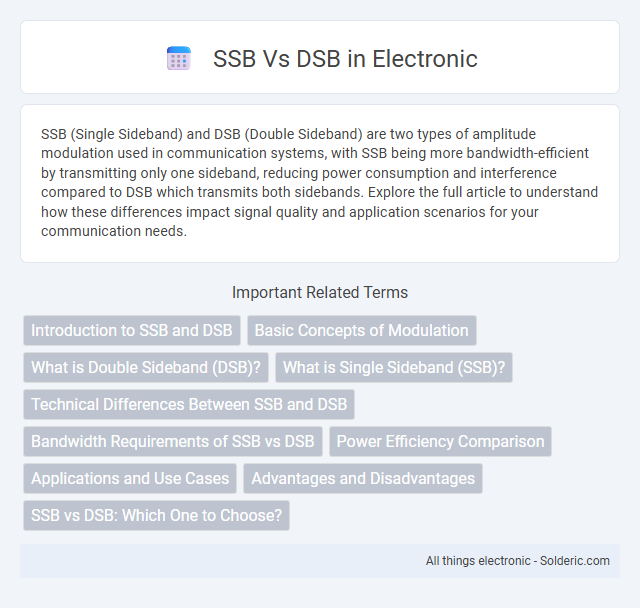SSB (Single Sideband) and DSB (Double Sideband) are two types of amplitude modulation used in communication systems, with SSB being more bandwidth-efficient by transmitting only one sideband, reducing power consumption and interference compared to DSB which transmits both sidebands. Explore the full article to understand how these differences impact signal quality and application scenarios for your communication needs.
Comparison Table
| Feature | SSB (Single Sideband) | DSB (Double Sideband) |
|---|---|---|
| Bandwidth | Half of DSB bandwidth (one sideband only) | Full bandwidth (both upper and lower sidebands) |
| Power Efficiency | High (power concentrated in one sideband) | Lower (power split between two sidebands) |
| Complexity | Higher (requires filtering or phasing) | Lower (simpler transmitter and receiver) |
| Signal Quality | Better spectral efficiency and less interference | More susceptible to fading and distortion |
| Use Case | Long-distance communications like amateur radio, aviation | AM broadcasting and simpler communication systems |
| Carrier Transmission | Suppressed or reduced carrier | Full carrier transmitted |
Introduction to SSB and DSB
Single Sideband (SSB) and Double Sideband (DSB) are amplitude modulation techniques used in communication systems. DSB transmits both upper and lower sidebands along with a carrier, resulting in greater bandwidth usage and power consumption. In contrast, SSB transmits only one sideband, significantly reducing bandwidth and improving power efficiency in voice and radio transmissions.
Basic Concepts of Modulation
Single Sideband (SSB) and Double Sideband (DSB) are fundamental amplitude modulation techniques used in communication systems, where DSB transmits both upper and lower sidebands symmetrically around the carrier frequency, resulting in higher bandwidth and power consumption. SSB transmits only one sideband, either upper or lower, significantly reducing bandwidth and improving power efficiency while preserving information content. Your choice between SSB and DSB affects spectral efficiency and transmitter design, critical for applications demanding bandwidth conservation and power optimization.
What is Double Sideband (DSB)?
Double Sideband (DSB) is a modulation technique where the carrier signal is transmitted along with two identical sidebands containing the same information, resulting in a fuller bandwidth occupancy. This method effectively duplicates the signal's spectrum, occupying twice the bandwidth of the original baseband signal. Your understanding of DSB is crucial for comparing its spectral efficiency and power usage with Single Sideband (SSB) modulation in communication systems.
What is Single Sideband (SSB)?
Single Sideband (SSB) is a refined form of amplitude modulation that transmits only one sideband, either the upper or lower, eliminating the carrier and the other sideband to reduce bandwidth usage. This efficient modulation technique significantly improves spectral efficiency and power utilization, making it ideal for long-distance communication such as amateur radio and maritime transmissions. SSB signals require precise demodulation methods and specialized receivers to recover the original audio content without distortion.
Technical Differences Between SSB and DSB
SSB (Single Sideband) and DSB (Double Sideband) differ technically in their signal transmission methods; SSB transmits only one sideband (either upper or lower), while DSB transmits both sidebands along with the carrier frequency. SSB is more bandwidth-efficient and power-efficient because it eliminates the redundant sideband and carrier, unlike DSB which uses twice the bandwidth and consumes more power. Understanding these differences helps you optimize communication systems for clarity, range, and energy consumption.
Bandwidth Requirements of SSB vs DSB
SSB (Single Sideband) modulation requires only half the bandwidth of DSB (Double Sideband) since it transmits a single sideband while suppressing the carrier and the other sideband. DSB transmits both upper and lower sidebands along with the carrier, effectively doubling the bandwidth needed compared to SSB. Using SSB can significantly optimize your bandwidth, making it more efficient for communication systems with limited spectrum resources.
Power Efficiency Comparison
SSB (Single Sideband) modulation offers significantly higher power efficiency compared to DSB (Double Sideband) by transmitting only one sideband and suppressing the carrier, reducing bandwidth and power requirements. In DSB, power is equally split between two sidebands and the carrier, resulting in energy waste and less efficient signal transmission. By choosing SSB, your communication system can achieve longer transmission distances with lower power consumption, making it ideal for bandwidth- and power-sensitive applications.
Applications and Use Cases
Single Sideband (SSB) modulation is widely used in amateur radio, maritime, and aviation communications due to its efficient bandwidth usage and reduced power consumption, making it ideal for long-distance voice transmissions. Double Sideband (DSB) finds applications in amplitude modulation broadcasting and certain analog communication systems where bandwidth efficiency is less critical but simplicity and signal fidelity are prioritized. SSB's advantage in spectrum efficiency and power savings makes it preferred for mobile and portable radio systems, while DSB is still relevant in simpler or legacy broadcast environments.
Advantages and Disadvantages
Single Sideband (SSB) modulation offers significant bandwidth efficiency by transmitting only one sideband, which reduces power consumption and minimizes interference compared to Double Sideband (DSB). However, SSB requires more complex and precise tuning at the receiver, making your equipment design and operation more challenging. In contrast, DSB is simpler to demodulate and implement but uses double the bandwidth of SSB and wastes power by transmitting both sidebands and the carrier.
SSB vs DSB: Which One to Choose?
Single Sideband (SSB) offers higher spectral efficiency and better power utilization compared to Double Sideband (DSB), making it ideal for bandwidth-constrained or long-distance communication. DSB transmits both upper and lower sidebands, resulting in higher power consumption and increased bandwidth usage, which can be less efficient in noisy environments. Choosing between SSB and DSB depends on the application: SSB suits voice and digital transmissions requiring clarity and range, while DSB may be preferred for simpler or legacy AM systems.
SSB vs DSB Infographic

 solderic.com
solderic.com